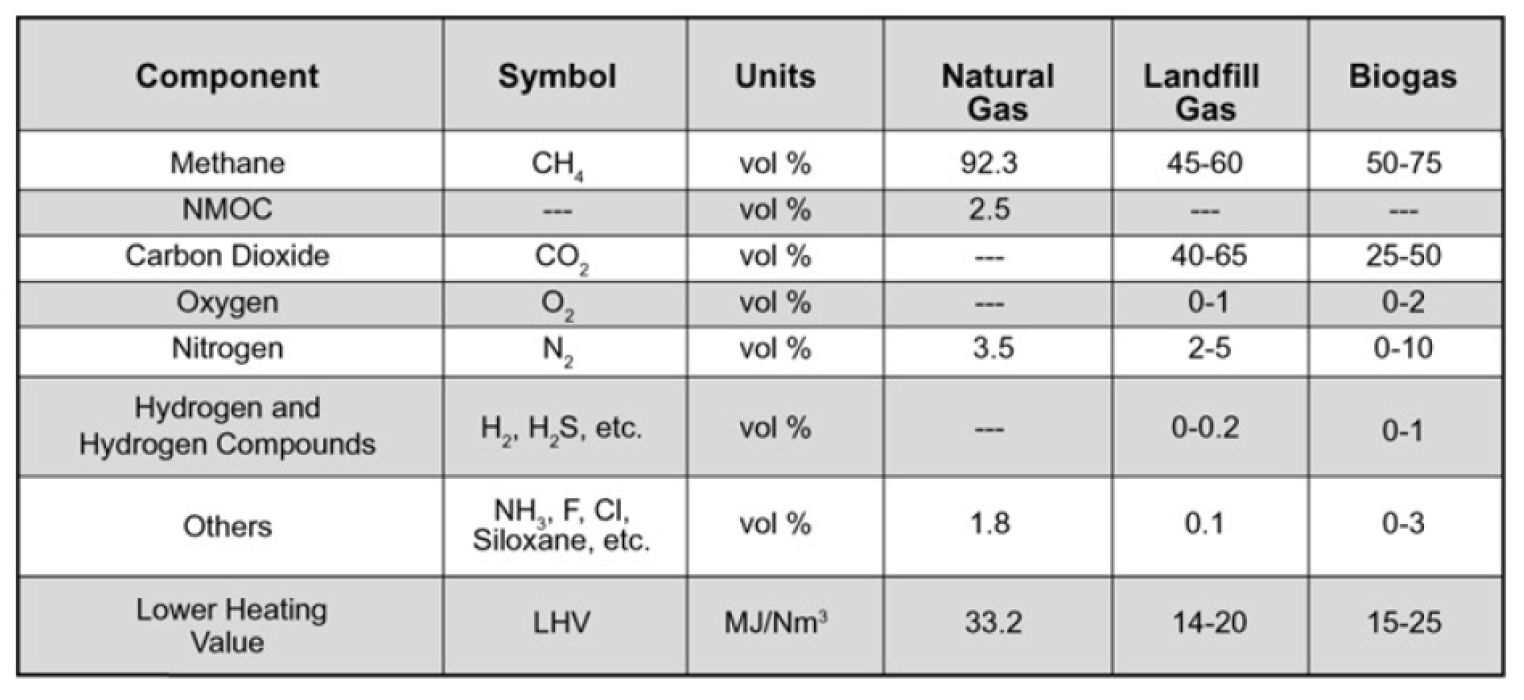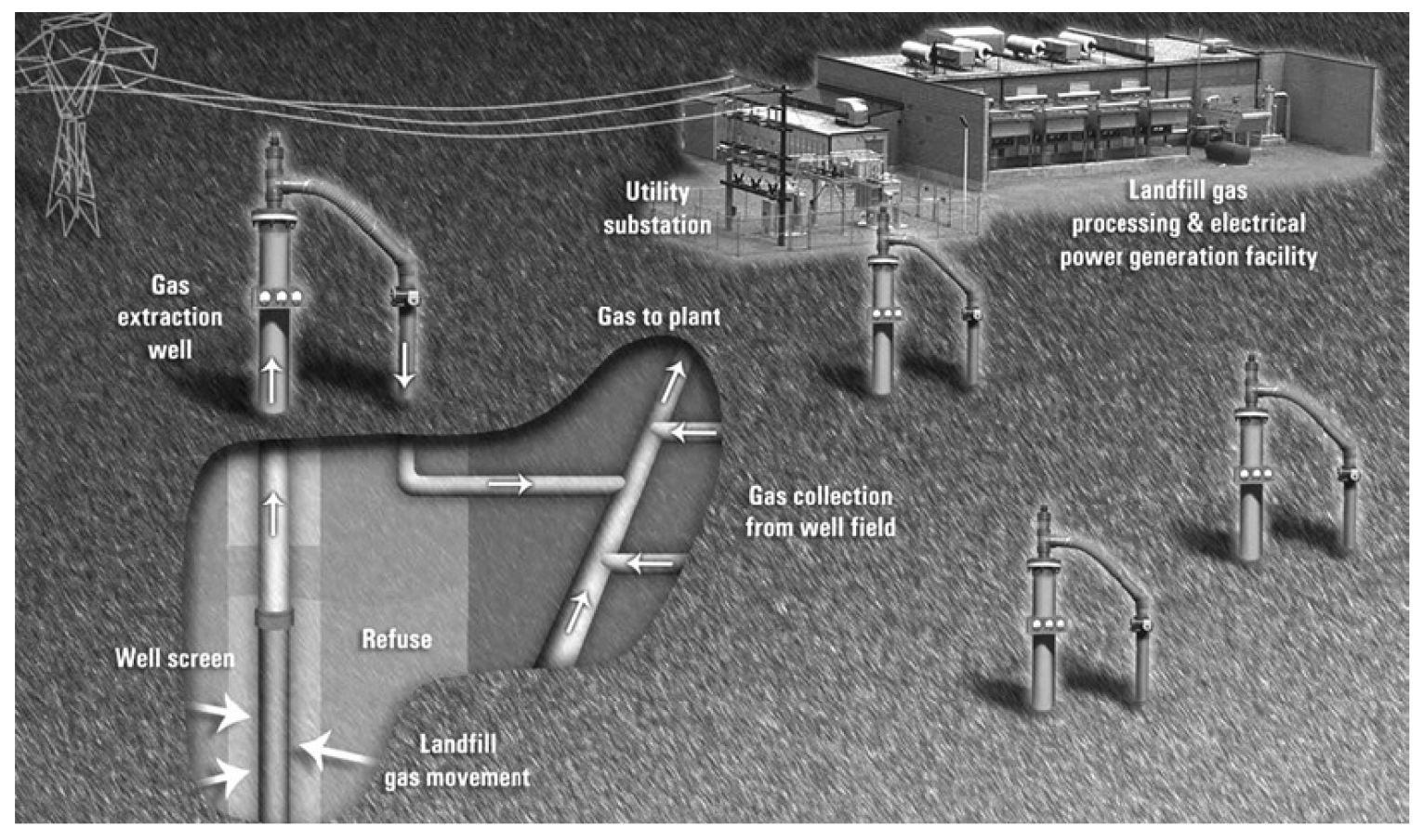RENEWABLE RESOURCES
Reciprocating generator sets offer the opportunity to maximize existing renewable resources, and one of the ways utilities may invest in efficient and renewable power is through projects like power generation from landfill gas, biogas and coal mine methane (CMM) gas. The option to run generator sets on methane and methane-based fuels means that a generator set on a farm, near a landfill or at a coal mining site can run on readily available waste resources, while providing heat and power to buildings and offices near those locations. Implementing methods to use methane in reciprocating generator sets instead of emitting it to the atmosphere also helps mitigate global warming and generates not only cost savings, but potential revenue.
Methane is released into the atmosphere through sources including landfill decomposition, agriculture and coal mining activities. Although methane occurs naturally in the atmosphere, it can be dangerous when released in large quantity. Emissions of methane have an estimated effect on global warming equal to 21 times the effect of carbon dioxide and, once released, methane remains in the atmosphere for approximately nine to 15 years. Landfill gas, biogas and coal mine methane are three of the most common and effective ways to run low energy-equipped reciprocating generator sets.
Landfill gas (LFG) is produced naturally as organic waste decomposes in landfills. LFG is composed of about 50 percent methane, about 50 percent carbon dioxide and a small amount of non-methane organic compounds (see Figure 1). A landfill must be at least 40 feet (12 meters) deep and have at least one million tons of waste in place for landfill gas collection and power production to be technically feasible. LFG develops in landfills in approximately one to three years, depending on the type of waste and make-up of the nearby terrain; peak production of LFG is five to seven years after waste is dumped.
At most municipal solid waste landfills, the methane and carbon dioxide mixture is destroyed in a gas collection and control system or utility flare. However, to use LFG as an alternative fuel, the gas is extracted from landfills using a series of wells and a vacuum system (illustrated in Figure 2). Pipes are inserted deep into the landfill to provide a point of release for the LFG. A slight vacuum is then applied in the pipe to draw the gases to a central point where they can be processed and treated for use in generating electricity, reducing the need for conventional fossil fuels.
Guelph Hydro in Guelph, Ontario, Canada, is a successful example of this landfill application. Located about 59 miles (95 kilometers) east of Toronto, Guelph Hydro has taken advantage of LFG-to-energy since 2005. Utilizing three Cat G3516LE gas engines coupled to 925 kW, 600V SRB4 generators with Cat switchgear and PowerLynx™ controls, the generating plant runs continuously with each engine requiring about 340 cubic feet per minute (cfm) of gas to operate at maximum output.
The G3516LE engines, operating at 1,200 rpm, are configured to be durable and reliable in burning low energy fuels without needing extensive fuel conditioning. The fuel treatment system at the Guelph landfill requires only a moisture removal system followed by a coalescing filter to remove remaining moisture droplets and particulates.
A specially designed cooling system elevates engine jacket water to the optimum temperature to prevent condensation of fuel-borne corrosive compounds. A crankcase ventilation pump ejects potentially acidic blow-by gases and draws in fresh, filtered air. In addition, aluminum and unprotected steel are eliminated from key components, such as aftercooler cores and main and connecting rod bearings.
The landfill has enough gas reserves to fuel the generators for about 20 years. Wells spaced 130 feet (39.624 meters) apart with an average depth of 50 to 65 feet (15.24 to 19.82 meters) capture methane from the landfill. Power from the plant goes to Guelph Hydro customers, equal to the needs of about 2,500 homes, meeting about one percent of the demand on its system. By turning the LFG to create electricity, the project has reduced pollutant emissions by about 100,000 tons or 90,718.47 metric tons per year, according to the Federation of Canadian Municipalities.
Globally, coal mines emit approximately 400 million metric tons or 28 billion cubic meters of carbon dioxide equivalent annually. About 8 percent of total anthropogenic methane emissions come from coal mines. This amount is equivalent to the consumption of 818 million barrels of oil or the carbon dioxide emissions of 64 million passenger cars. In 2005, U.S. coal mines emitted about 4 billion cubic meters of methane. Between 1994 and 2005, U.S. emissions decreased by over 20 percent, in large part due to the coal mining industry’s increased recovery and utilization of drained gas. China leads the world in coal mine methane emissions with about 14 billion cubic meters of CO2 equivalent emitted annually – a 2004 measurement estimated nearly 200 million metric tons were emitted that year. Aside from the U.S. and China, other leading emitters include Ukraine, Australia, Russia and India. [1]
Similar to LFG, biogas is produced through the natural anaerobic decomposition or fermentation of organic waste, such as manure, municipal solid waste, biodegradable waste or any other biodegradable feedstock within an anaerobic environment. Biogas consists primarily of methane (50 to 80 percent) and carbon dioxide (20 to 50 percent), with trace levels of other gases such as hydrogen, carbon monoxide, nitrogen, oxygen and hydrogen sulfide.
Biogas can be extracted for use with reciprocating generator sets from almost any of its sources. For example, some livestock farms or large livestock feeder operations use a lagoon to cover and store the manure generated by their livestock. Instead of releasing the methane and carbon dioxide generated by the decomposition of this manure into the atmosphere, the methane can be extracted and burned at the farm in biogas-fueled gas engines. Other agricultural operations, like starch-producing cassava processing plants, utilize anaerobic biodigesters to convert organic-rich wastewater into methane. By tapping their biogas resources, these farms and plants supplement their own power generation capabilities and lower their costs of purchasing heavy fuel oil and electricity (illustrated in Figure 3).
Coal mine methane is another option for using cleaner fuel in reciprocating generator sets. At coal mining sites, gas drainage systems can be used to extract the methane-rich gas that exists in coal beds. Similar to the method used in landfills, vertical or horizontal wells are drilled into the coal bed and vacuum pressure extracts the methane. This type of extraction can yield very high quality gas, often with a methane content above 85 percent being common, especially from wells drilled into the coal seam well ahead of the actual mining. Wells drilled into the face of the coal seam as it is being mined typically have more air mixed with the methane gas as it is gathered; this gas is generally composed of 25 to 60 percent methane.
Maxim Power Corporation of British Columbia, Canada, found that by installing a Cat G3520C generator set alongside three existing cogeneration units at a power plant on Vancouver Island, they were able to increase the amount of power they supply to the local utility by 1.6 MW. The engine’s power density rating of 80 kW per cylinder and relatively low operating cost per kW (better than other engines in this application) augment its capability of utilizing low BTU methane gas as fuel. Running at 1,200 rpm, the G3520C, produces 2,144 horsepower and supplies 600 volts. Its switchgear and step-up transformer convert this to 25,000 volts for sale to BC Hydro under Canada’s green energy purchase program.
Working in tandem with the cogeneration units, the G3520C helps the plant recover 6.7 MW of heat from exhaust, water jacket, intercoolers and oil exchangers to provide 194°F (90°C) water for the a local greenhouse’s boiler. The generator sets use close to 100 percent of the methane from the landfill and capture more than 85 percent of the total available energy in power and heat. No flaring is necessary.
CATERPILLAR SOLUTIONS
To meet the needs of customers seeking to use biogas as fuel, Caterpillar offers the G3520C low-energy fuel generator set for use with methane fuels found in landfills, coal mines and other low-energy biogas environments. The new generator set includes equipment that optimizes the performance of engines in parallel-to-grid, continuous-operation applications. This generator set was specially designed to handle fuel with methane concentration variations that are typical of landfill, biogas and CMM operations. The G3520C package is also designed to efficiently and reliably use fuel gas with lowerthan-typical methane content. Special approval and engine configurations can be arranged for applications with methane content as low as 25 percent.
Protections like special “hardened” features are also available on the G3520C generator set to offer security against the corrosive nature of biogas and LFG in situations where minimal fuel pretreatment is desirable. For example, the landfill-specific design minimizes the use of bright metals such as copper and unprotected steel in components likely to come in contact with the fuel or exhaust gases, which are naturally acidic. The aftercooler cores, made of copper alloys in standard gas engines, are made of stainless steel in Cat landfill generator sets to resist attack from the acids in sulfur, chlorine and fluorine.
Equipped with a gas engine control module using ADEM™ III electronic controls, the generator set allows for full engine control from a single source. It can utilize fuel from a range of 25 to 100 percent methane, so the equipment remains efficient throughout the life of a landfill or coal mining project.
The Cat G3520C is available in both 50 and 60Hz models and can be used in LFG, biogas and CMM applications across the globe. Current power projects using this reciprocating generator set include a 9.6 LFG power plant in San Antonio, Texas, a 120 MW CMM power plant in Jincheng, China, and a 1.6 MW wastewater treatment facility in Hamilton, Ontario, Canada.
FUEL FLEXIBILITY AND ENERGY SECURITY
Looking forward, it is important to also consider the contribution of CHP, utility management of efficiency and conservation programs, and renewable resources to overall energy security. Reciprocating generator sets are fuel flexible, making them a cornerstone of one possible strategy for reducing the United States’ dependence on foreign oil and non-renewable resources like coal. Energy independence is a topic of great interest globally. The recognition that many highly used resources are finite is leading many countries to explore and expand on renewable resources, and there are persistent concerns for issues like natural disasters, regional conflicts or supply manipulation in countries that provide oil and coal to the rest of the world. Reducing vulnerability to drastic changes in the energy market is important to ensure affordable and reliable power for infrastructure, home and business use.
LFG and biogas may both be used to power fuel-flexible reciprocating generator sets, but low nitrogen oxide-producing natural gas may also be used. The efficiency of the generator sets is proven, with their ability to capture and reuse waste heat for CHP applications, while meeting national and local standards for emissions. When utilities are encouraged through decoupling to take advantage of the benefits of renewable fuels and CHP systems, those benefits can be managed from a central source and distributed locally to consumers, allowing communities to be involved with the process of creating and conserving the energy they use.
Energy security may only become a reality when all the contributing entities are willing and able to invest in available national resources. Beginning with promoting an existing technology like reciprocating generator sets may lead to essential change in the way power is produced, sold and distributed, leading to a United States that runs on clean, efficient, local power.
REFERENCES
[1] Oregon department of Energy. “Biogas Technology.” Retrieved 7 August 2008 from http://www.oregon.gov/ENERGY/RENEW/Biomass/biogas.shtml#landfill_gas








